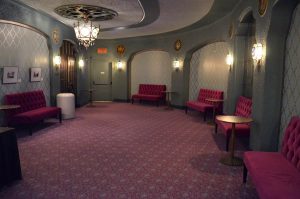Did You Know – Sound & Light Locks
CLICK – <Blast of light> – THUNK. That’s the experience I have when I watch a show at my daughter’s high school theatre. The source of disturbance is another audience member entering or leaving the auditorium during a show. It does not have to be that way though.
All performance spaces need sound and light locks. They are simple transition spaces between the public lobby areas and the auditorium. Some people might call them “vestibules”, but whatever the label, they have an important function. These spaces separate the sound and light of the public spaces from the controlled audience space. Some key features found in most sound and light locks:
- Lower light levels reduce interruption for the audience watching a performance. The light inside should be bright enough to meet code requirements and for audience members to navigate but dark enough to avoid that dreaded light leaking into the seating area when the inner door is opened.
- Two doors in series create a sound barrier from the outer, public spaces. Typically, the inner or audience-side door will have only push plates and gaskets to reduce noise. Locks, latches, and fire ratings should be at the outer, lobby-side doors.
- The interior surfaces are commonly treated to be sound absorptive. Color may be subdued to reduce light reflectance when the door is open.

The vestibule at the rear orchestra seating of the Capitol Theatre, Overture Center, Madison, WI. Most Sound and Light Locks are not very photogenic, but this area serves the purpose while also being a lounge area. Photo by Paul G. Sanow, ASTC
These sound and light locks also suggest to the audience they are transitioning to a new space, and it may be time to be quiet, especially when entering an auditorium during a performance. Changes in materials can help signal the transition, including carpeting, colors, and other changes in appearance. These spaces also help one’s eyes to adjust to differing light levels while transitioning to and from the auditorium. Lighting should be on a separate dimmer, while also making sure there is emergency egress lighting during a fire alarm or loss of normal power.
Sound and light locks are not just for audiences. They are important around stages and other entry points. Stage sound and light locks serve the same purpose, in this case separating a (sometimes) chaotic backstage from the stage. They are needed anywhere there is a transition between outer corridors and the performance space.
Sound and Light Locks are some of the most important areas of a performance space. They can be as simple as a series of doors at each entry, with code minimum space between each door. In the past these were sometimes larger areas, with multiple doors and even furniture, drinking fountains, and other amenities. It doesn’t matter how the space is shaped, so long as it’s there.
By Paul G. Sanow, ASTC
Disclaimer: Any views or opinions expressed in this article are solely those of the author and do not necessarily represent those of the American Society of Theatre Consultants. This article is for general information only and should not be substituted for specific advice from a Theatre Consultant, Code Consultant, or Design Professional, and may not be suitable for all situations nor in all locations.


